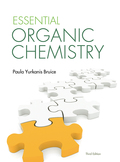
EBK ESSENTIAL ORGANIC CHEMISTRY
3rd Edition
ISBN: 8220100659461
Author: Bruice
Publisher: PEARSON
expand_more
expand_more
format_list_bulleted
Concept explainers
Question
Chapter 16, Problem 23P
Interpretation Introduction
Interpretation:
The product obtained from the reaction of D-ribose with one equivalent of methanol and
Concept Introduction:
The hydroxyl group of anomeric carbon is protonated by an acid. The lone pair on the ring helps in eliminating a molecule of water which results in the formation of oxocarbenium ion. It is planar molecule. When the alcohol approaches from the top of the plane, the
Expert Solution & Answer
Want to see the full answer?
Check out a sample textbook solution
Students have asked these similar questions
. Each of the following compounds can be prepared by a mixed aldol condensation reaction. Give the
Cructures of the aldehyde and/or ketone precursors for each aldol product and formulate the reaction.
0
CH=CHCCH
3.
Ph
1
. Consider the reaction below to answer the following question:
H
NaOEt
H
BOH
بلی
H
+ H₂O
A. Write the complete stepwise mechanism for the reaction above. Show all intermediate structures
and all electron flow with arrows.
B. This reaction is an example of:
an intramolecular aldol condensation
a.
an intramolecular Claisen condensation
b.
C.
d.
a Robinson annulation
a Michael reaction
C. The product of this reaction is:
a.
b.
C.
d.
a ẞ. y-unsaturated aldehyde
an a, B-unsaturated ketone
an a, B-unsaturated aldehyde
an enol
Classify each of the following nitrogen atoms in the following compounds as primary, secondary,
tiary, or quaternary.
A.
B.
C.
CH3
HO-CHCHNHCH3
ephedrine
CH CHCH3 amphetamine
NH₂
D.
CF
H3C CH3
mapiquat chloride
HO
fexofenadine
OH
H3C
CH3
CO₂H
Chapter 16 Solutions
EBK ESSENTIAL ORGANIC CHEMISTRY
Ch. 16.1 - Prob. 1PCh. 16.2 - Prob. 2PCh. 16.3 - Prob. 3PCh. 16.3 - Prob. 4PCh. 16.4 - Prob. 5PCh. 16.4 - Prob. 6PCh. 16.5 - Prob. 7PCh. 16.5 - Prob. 8PCh. 16.6 - Prob. 10PCh. 16.8 - Prob. 12P
Ch. 16.8 - Prob. 14PCh. 16.9 - Prob. 15PCh. 16.10 - Prob. 16PCh. 16.11 - Refer to Figure 16.4 to answer the following...Ch. 16 - Prob. 18PCh. 16 - Prob. 19PCh. 16 - Prob. 20PCh. 16 - Prob. 21PCh. 16 - Prob. 22PCh. 16 - Prob. 23PCh. 16 - Prob. 24PCh. 16 - Prob. 25PCh. 16 - Name the following compounds:Ch. 16 - Prob. 28PCh. 16 - Prob. 29PCh. 16 - Prob. 31PCh. 16 - Prob. 32PCh. 16 - Prob. 33PCh. 16 - Prob. 34PCh. 16 - Prob. 35PCh. 16 - Prob. 36PCh. 16 - Prob. 37PCh. 16 - Draw the mechanism for the acid-catalyzed...Ch. 16 - Prob. 39PCh. 16 - Prob. 40PCh. 16 - Prob. 41P
Knowledge Booster
Learn more about
Need a deep-dive on the concept behind this application? Look no further. Learn more about this topic, chemistry and related others by exploring similar questions and additional content below.Similar questions
- .. Name each of the following compounds by IUPAC rules. [three Only] A. 0 B. C. Cl NH₂ OCH N CH3 NHCH2CH3 D. CH O₁₂N NH₂arrow_forwardDraw the structure of the aldol self condensation product for each of the following compounds if a compound does not under go aldol self condensation explain whyarrow_forwardIndicate how the addition of a nucleophile :NuH2 to a ketone R-CO-R occurs.arrow_forward
- Indicate the compound that gives us a primary carbocation and that gives us a secondary carbocation: R-CHO and R-CO-Rarrow_forwardDraw a stepwise mechanism for the following reaction. OHarrow_forwardHelp with annotating the labeled peaks in the 'H NMR (solvent CDCls) spectra and 'H NMR (solvent Acetone-D6) spectra Also help with Calculating the keto-enol tautomerization Ka constant for the product in both solvents.Two solvents and two different Kaarrow_forward
- Draw a Haworth projection of a common cyclic form of this monosaccharide CH₂OH HO H HO H H OH CH₂OHarrow_forwardCan you explain how I get these here and show the steps plz?arrow_forwardGive the IUPAC name for this compound Hydrocarbon Condensed Formulas Hint C2H5 CH2CH3 expand that in all the formula Part A: (CH3)2CHCH(C2H5)CH2CH2CH3 Give the IUPAC name for this compound. Part B: CH2=C(C2H5)CH2CH2CH3 Give the IUPAC name for this compound. Part C: (CH3)2C=CHC(C2H5)=CH2 Give the IUPAC name for this compound. Part D: CH3C=CCH(C2H5)2 Give the IUPAC name for this compound. Part E: (CH3)3CC=CCH2CH=C(CH3)2arrow_forward
- Select/ Match the correct letter from the image below for the IUPAC names given below: A B C D 3 E F G H K L Part 1. 4-methylheptane For example.mmmm Answer Letter H _for part 1 Part 2. 2,4-dimethylhexane Part 3. 2,3-dimethylpentane Part 4. 2,2-dimethylhexane Part 5. 2-ethyl-1,1,3,3-tetramethylcyclopentane Part 6. 3-ethyl-2-methylpentanearrow_forwardCan u show the process as to how to get these?arrow_forwardSketch the expected 'H NMR spectra for the following compound. Label all of the H's in the structure and the corresponding signal for the spectra you sketch. Make sure you include the integration value and the splitting pattern for each signal Indicate how many signals you would expect in the 13C NMRarrow_forward
arrow_back_ios
SEE MORE QUESTIONS
arrow_forward_ios
Recommended textbooks for you
 Introduction to General, Organic and BiochemistryChemistryISBN:9781285869759Author:Frederick A. Bettelheim, William H. Brown, Mary K. Campbell, Shawn O. Farrell, Omar TorresPublisher:Cengage Learning
Introduction to General, Organic and BiochemistryChemistryISBN:9781285869759Author:Frederick A. Bettelheim, William H. Brown, Mary K. Campbell, Shawn O. Farrell, Omar TorresPublisher:Cengage Learning

Introduction to General, Organic and Biochemistry
Chemistry
ISBN:9781285869759
Author:Frederick A. Bettelheim, William H. Brown, Mary K. Campbell, Shawn O. Farrell, Omar Torres
Publisher:Cengage Learning
